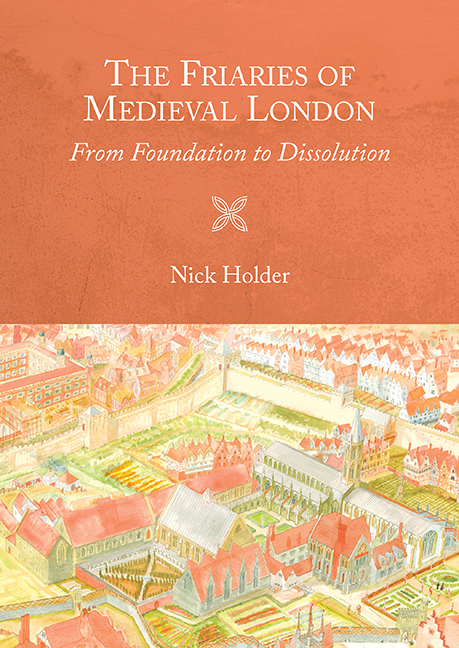Book contents
- Frontmatter
- Contents
- List of Illustrations and Tables
- Contributors
- Acknowledgements
- Abbreviations
- Introduction
- Part I The Nine London Friaries
- Part II The London Friars and their Friaries
- 10 Churches
- 11 Precincts and the Use of Space
- 12 Architecture and Architectural Fragments of the London Friaries
- 13 Floor Tiles and Building Materials from the London Friaries
- 14 Water Supply
- 15 Economy
- 16 Spiritual Life and Education in the London Friaries
- 17 Burial and Commemoration in the London Friaries
- 18 London Friars and Londoners
- 19 Dissolution
- Conclusions
- Timeline
- Bibliography
- Index
- Miscellaneous Endmatter
19 - Dissolution
from Part II - The London Friars and their Friaries
Published online by Cambridge University Press: 16 May 2018
- Frontmatter
- Contents
- List of Illustrations and Tables
- Contributors
- Acknowledgements
- Abbreviations
- Introduction
- Part I The Nine London Friaries
- Part II The London Friars and their Friaries
- 10 Churches
- 11 Precincts and the Use of Space
- 12 Architecture and Architectural Fragments of the London Friaries
- 13 Floor Tiles and Building Materials from the London Friaries
- 14 Water Supply
- 15 Economy
- 16 Spiritual Life and Education in the London Friaries
- 17 Burial and Commemoration in the London Friaries
- 18 London Friars and Londoners
- 19 Dissolution
- Conclusions
- Timeline
- Bibliography
- Index
- Miscellaneous Endmatter
Summary
IT must have been quite extraordinary to live in England during that heady and dangerous decade of the 1530s. The English Reformation – a retrospective and over-neat label – was set in motion by a strange chain of events involving great men like Erasmus and Luther, and, closer to home, Henry VIII with his interleaving dynastic, personal and religious worries. The sense of unpredictability must have been particularly strong in London where close proximity to court, Church and parliament would have sent rumours and opinions flying around the city. The priors of the five London friaries must have seen the end coming in the 1530s, but exactly when they realised it was inevitable is harder to say.
The 1530s: a decade of uncertainty
Four of the London priors were closely allied with Thomas Cromwell and the rapidly evolving Crown policy (the exception seems to have been the Carmelite prior, John Gybbes). George Brown of Austin Friars had been taking precautions and making changes for a few years, even before 1534 when the king's commissioners (led by the prior of the London Dominicans, John Hilsey) were sent to investigate England's mendicant houses. In March 1531 Brown had leased a mansion and garden within the friary precinct to Thomas Paulet, brother of the courtier William Paulet. In May the following year, Brown enhanced the friary's ties to its influential tenant Thomas Cromwell (by then Henry's principal secretary) by granting him a ninety-nine-year lease on a block of houses on the edge of the precinct so that he could redevelop it as a grand urban mansion. Brown later welcomed two wellconnected protégés of Cromwell as tenants, Richard Rich and Richard Morrison (in 1536 and 1538 respectively). Of course, as an ally of Cromwell, Brown may have been seeking to secure his own position rather than that of his priory. The Dominican prior, John Hilsey, began renting out what he saw as under-used parts of his cloisters to courtiers in the early 1530s. Like the prior of Austin Friars, Hilsey was almost certainly acting to safeguard his own future. The Grey Friars guardian, Thomas Chapman, was another supporter of Cromwell, although he does not seem to have taken the same steps to bring in influential tenants.
- Type
- Chapter
- Information
- The Friaries of Medieval LondonFrom Foundation to Dissolution, pp. 305 - 312Publisher: Boydell & BrewerPrint publication year: 2017



